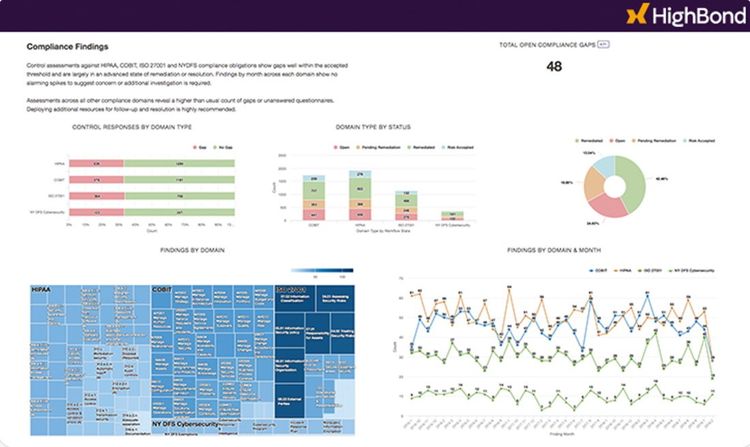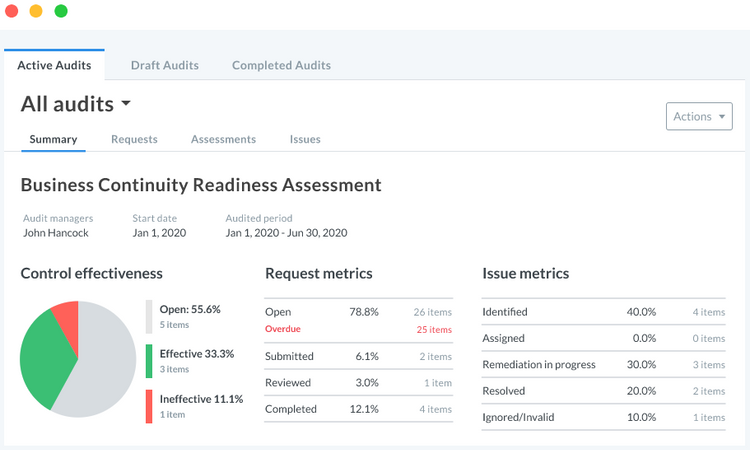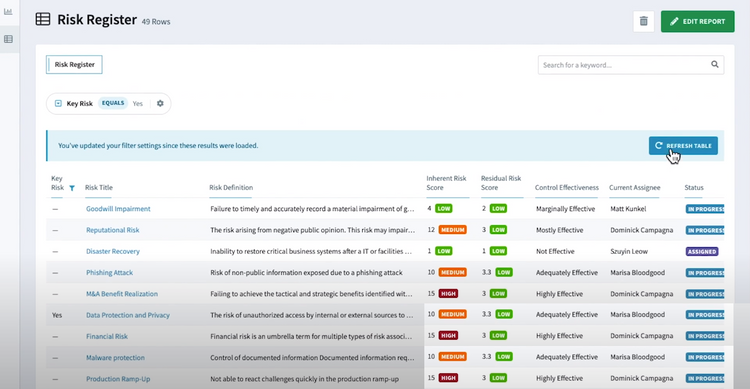The Best GRC Software
Get the best software for your business. Compare product reviews, pricing below.
What is GRC Software?
Governance, risk, and compliance (GRC) software, sometimes expanded to governance risk management and compliance software, assists businesses with regulatory security measures. Similar to traditional risk management solutions, which attempt to limit workplace risk and mitigate potential damages, this software has an additional focus on maintaining compliance with government regulations.
GRC systems establish processes for measuring risk factors within your organization, then identify how to prevent incidents based on local, federal, or international policy. Since safety regulations can change based on location, this software helps your business remain compliant based on the specifications of each jurisdiction.
Compliance platforms are sometimes divided into the following segments:
- Financial
- Information Technology (IT)
- Legal
While these different business areas have varied focuses, all have the same overall goal when utilizing GRC: protect a business from uncertainty while safely operating workflow according to government standards. GRC solutions are used by all sorts of businesses, particularly those which regularly deal with national or international regulations.

GRC Software Features
- Policy and document management: Write and standardize internal safety policy for your business; share documents detailing safety protocols and regulations with members of your organization
- Compliance management: Plan workplace operations in accordance with set safety regulations
- Risk management and analytics: Review historical data for your company and industry to better predict potential risks for your business; plan out ways to mitigate these potential risks
- Environmental compliance: Maintain environmentally conscious business practices based on local or international regulations
- IT risk management: Secure your digital assets and protect your online information
- Incident management: Minimize and mitigate damages from incidents; have predetermined plans in place for how to approach and handle specific risk situations
- Audit management: Ensure all necessary documentation is available in the event of internal audit or government-mandated audits
- Disaster recovery: Guide your organization through severe incidents or accidents to prevent injury to personnel or consumers, damage to equipment and facilities, or lost revenue

Best GRC Software Benefits
Governance, risk and compliance software provides many useful benefits for businesses:
Promote Safe Work Practices
GRC software streamlines safety processes into one easily accessible compliance platform, automating your regulatory compliance processes. By containing all your safety information within one compliance platform, your Chief Risk Officer (CRO) can update or adjust existing protocol based on changing government standards. Then, all your workers can check the new regulations and provide suggestions for improvement.
Additionally, a GRC software provides your employees with an easily accessible resource listing all required safety protocols, allowing them to train and work in safer conditions. Document management tools make it easy to pull up and share specific documentation regarding different standards and regulations so everyone is on the same page when it comes to compliance.
Remain Compliant with Local and International Standards
Any business with international relationships knows the hassles of maintaining compliance with dozens of different regulatory agencies. Every organization has different standards and are regularly making changes to their official policy to meet new levels of safety. While this is good for protecting businesses, workers, and consumers alike, it can lead to expensive restructuring when it’s time to implement these new standards.
Some government entities which may regulate your industry include:
- Occupational Safety and Health Administration (OSHA)
- Securities and Exchange Commission (SEC)
- Food and Drug Administration (FDA)
- American Society of Safety Engineers
- Chemical Safety Board (CSB)
GRC software creates a single platform for maintaining your risk and compliance management, even as protocols change around you. Whether you’re the CRO or head of the legal department, you can keep tabs on new policy and ensure your organization is ready to adapt. This can give you a leg up on your competitors who may fall behind on safety regulations and have to suspend workflow operations until they meet current compliance. Being proactive with your safety measures can be the difference between a government-required shutdown and a continued production schedule.

Protect Digital Data
GRC software provides more than just protection to your physical workspaces; it can secure your digital assets. Just like general safety standards, IT-related cybersecurity is always evolving, though at a significantly faster rate. Perform regular self-assessments to measure your potential IT risks and stay ahead of online threats.
For example, companies with international branches may have an online system for sharing data such as invoices in real-time. This can create an IT vulnerability, as different countries may have different Internet regulations regarding how information can be distributed. With a compliance platform, you can control your IT security at every facility you operate. Set your own internal standards for sharing data in order to minimize risk to business continuity.
Stay Safe after Incidents
Accidents happen, no matter how many safety precautions you have in place. Fortunately, a GRC platform offers highly configurable tools for incident management and disaster recovery. For example, if your facility is in an area with a history of flooding, it makes sense to have a detailed incident plan in place in the event of flood conditions in order to reduce the impact on your operations. You cannot prevent a flood, but you can be well-prepared for the possibility. These plans should be developed by your CRO, legal department, or IT sector to automate your incident management response exactly in the event it is ever needed.
In the event of a worst case scenario, disaster recovery modules help you guide your decision-making through unexpected situations. Using these measures can prevent additional damage to your operations while keeping you compliant with relevant government agencies. In turn, this attention to business continuity can save you from lost revenue from paying fines for safety violations.
GRC Software Implementation Options
GRC solutions can be distributed in three ways: as an on-premise software, through the Cloud, or as a hybrid system. Each offers different benefits, particularly in how secure they are for your specific industry. For instance, implementing an on-premise solution is ideal for businesses which need incredibly secure data in one physical location. These systems can be designed to keep an internal network as secure as possible. A hybrid solution is better suited for companies with multiple facilities so they can promote shared communication while still controlling localized safety standards.

